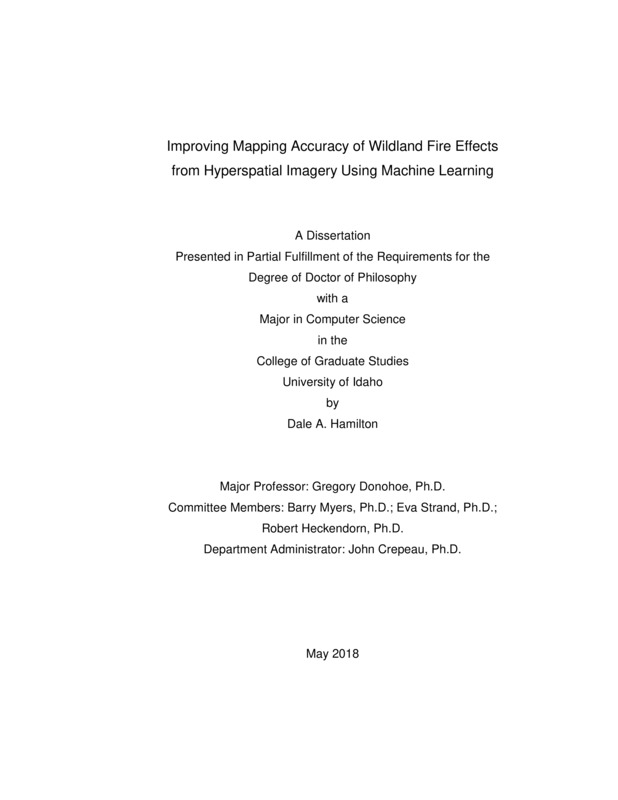Improving Mapping Accuracy of Wildland Fire Effects from Hyperspatial Imagery Using Machine Learning
Hamilton, Dale. (2018-05). Improving Mapping Accuracy of Wildland Fire Effects from Hyperspatial Imagery Using Machine Learning. Theses and Dissertations Collection, University of Idaho Library Digital Collections. https://www.lib.uidaho.edu/digital/etd/items/hamilton_idaho_0089e_11301.html
- Title:
- Improving Mapping Accuracy of Wildland Fire Effects from Hyperspatial Imagery Using Machine Learning
- Author:
- Hamilton, Dale
- ORCID:
- 0000-0003-4234-6512
- Date:
- 2018-05
- Keywords:
- Fire Ecology Hyperspatial Imagery Image Processing Machine Learning Small Unmanned Aircraft Systems
- Program:
- Computer Science
- Subject Category:
- Computer science; Ecology
- Abstract:
-
This dissertation presents the potential of small unmanned aircrafts systems (sUAS) to provide affordable, on-demand monitoring of wildland fire effects at a much finer spatial resolution than is possible with the current approaches using satellites or manned aircraft.
Wildfires burn 4-10 million acres across the United States with suppression costs approaching $2 billion annually. High intensity wildfires contribute to post fire erosion, flooding and loss of timber resources. Accurate assessment of the effects of wildland fire on the environment is critical to improving the management of wildland fire as a tool for restoring ecosystem resilience.
Sensor miniaturization and sUAS offer a new paradigm, providing affordable, on-demand monitoring of wildland fire effects at a much finer spatial resolution than is possible with satellite or manned aircraft, providing finer detail at a much lower cost. This increased resolution contains post-fire effects information that has not been previously detectable, such as white ash and individual plants.
The approaches examined for improving the extraction of post-fire effects knowledge from hyperspatial imagery acquired with a sUAS include:
1. Showing that burn severity classes of interest were mapped more accurately from hyperspatial than 30 meter color imagery.
2. When texture was added to color as a fourth hyperspatial input to machine learning algorithms, burn severity classes of interest were mapped more accurately.
3. Wildland fire effects were mapped with higher accuracy using Support Vector Machines than was achieved with k-Nearest Neighbor classifiers when mapping wildland burn severity classes using hyperspatial color imagery.
Each of these three approaches resulted in an increase of accuracy by which post-fire effects were mapped from a set of orthomosaics acquired with a sUAS over a variety of wildland fires.
Development of tools, methods and metrics which utilize hyperspatial sUAS multi-spectral imagery enable managers to monitor fire effects at a much finer resolution than is possible with current technology, providing new knowledge to assist with post-fire ecosystem management. This information will allow for the realization of optimized management and decreased associated costs leading to improved data-driven land management decisions resulting in fire resilient ecosystems.
- Description:
- doctoral, Ph.D., Computer Science -- University of Idaho - College of Graduate Studies, 2018-05
- Major Professor:
- Donohoe, Gregory
- Committee:
- Myers, Barry; Strand, Eva; Heckendorn, Robert
- Defense Date:
- 2018-05
- Identifier:
- Hamilton_idaho_0089E_11301
- Type:
- Text
- Format Original:
- Format:
- application/pdf
- Rights:
- In Copyright - Educational Use Permitted. For more information, please contact University of Idaho Library Special Collections and Archives Department at libspec@uidaho.edu.
- Standardized Rights:
- http://rightsstatements.org/vocab/InC-EDU/1.0/

